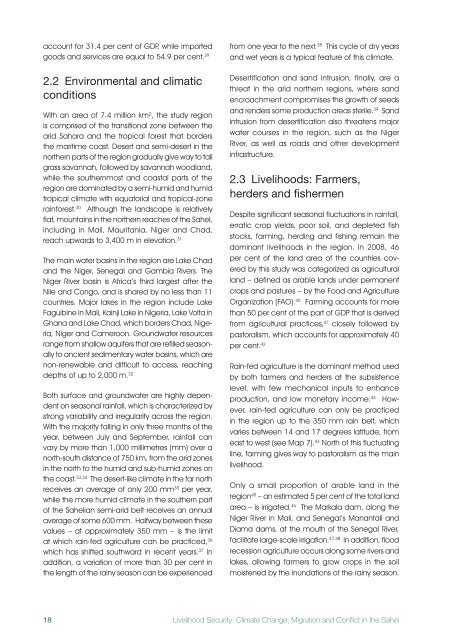Livelihood Security: Climate change, conflict and migration in - UNEP
Livelihood Security: Climate change, conflict and migration in - UNEP
Livelihood Security: Climate change, conflict and migration in - UNEP
You also want an ePaper? Increase the reach of your titles
YUMPU automatically turns print PDFs into web optimized ePapers that Google loves.
account for 31.4 per cent of GDP, while imported<br />
goods <strong>and</strong> services are equal to 54.9 per cent. 29<br />
2.2 Environmental <strong>and</strong> climatic<br />
conditions<br />
With an area of 7.4 million km², the study region<br />
is comprised of the transitional zone between the<br />
arid Sahara <strong>and</strong> the tropical forest that borders<br />
the maritime coast. Desert <strong>and</strong> semi-desert <strong>in</strong> the<br />
northern parts of the region gradually give way to tall<br />
grass savannah, followed by savannah woodl<strong>and</strong>,<br />
while the southernmost <strong>and</strong> coastal parts of the<br />
region are dom<strong>in</strong>ated by a semi-humid <strong>and</strong> humid<br />
tropical climate with equatorial <strong>and</strong> tropical-zone<br />
ra<strong>in</strong>forest. 30 Although the l<strong>and</strong>scape is relatively<br />
flat, mounta<strong>in</strong>s <strong>in</strong> the northern reaches of the Sahel,<br />
<strong>in</strong>clud<strong>in</strong>g <strong>in</strong> Mali, Mauritania, Niger <strong>and</strong> Chad,<br />
reach upwards to 3,400 m <strong>in</strong> elevation. 31<br />
The ma<strong>in</strong> water bas<strong>in</strong>s <strong>in</strong> the region are Lake Chad<br />
<strong>and</strong> the Niger, Senegal <strong>and</strong> Gambia Rivers. The<br />
Niger River bas<strong>in</strong> is Africa’s third largest after the<br />
Nile <strong>and</strong> Congo, <strong>and</strong> is shared by no less than 11<br />
countries. Major lakes <strong>in</strong> the region <strong>in</strong>clude Lake<br />
Faguib<strong>in</strong>e <strong>in</strong> Mali, Ka<strong>in</strong>ji Lake <strong>in</strong> Nigeria, Lake Volta <strong>in</strong><br />
Ghana <strong>and</strong> Lake Chad, which borders Chad, Nigeria,<br />
Niger <strong>and</strong> Cameroon. Groundwater resources<br />
range from shallow aquifers that are refilled seasonally<br />
to ancient sedimentary water bas<strong>in</strong>s, which are<br />
non-renewable <strong>and</strong> difficult to access, reach<strong>in</strong>g<br />
depths of up to 2,000 m. 32<br />
Both surface <strong>and</strong> groundwater are highly dependent<br />
on seasonal ra<strong>in</strong>fall, which is characterized by<br />
strong variability <strong>and</strong> irregularity across the region.<br />
With the majority fall<strong>in</strong>g <strong>in</strong> only three months of the<br />
year, between July <strong>and</strong> September, ra<strong>in</strong>fall can<br />
vary by more than 1,000 millimetres (mm) over a<br />
north-south distance of 750 km, from the arid zones<br />
<strong>in</strong> the north to the humid <strong>and</strong> sub-humid zones on<br />
the coast. 33,34 The desert-like climate <strong>in</strong> the far north<br />
receives an average of only 200 mm 35 per year,<br />
while the more humid climate <strong>in</strong> the southern part<br />
of the Sahelian semi-arid belt receives an annual<br />
average of some 600 mm. Halfway between these<br />
values – at approximately 350 mm – is the limit<br />
at which ra<strong>in</strong>-fed agriculture can be practiced, 36<br />
which has shifted southward <strong>in</strong> recent years. 37 In<br />
addition, a variation of more than 30 per cent <strong>in</strong><br />
the length of the ra<strong>in</strong>y season can be experienced<br />
18<br />
from one year to the next. 38 This cycle of dry years<br />
<strong>and</strong> wet years is a typical feature of this climate.<br />
Desertification <strong>and</strong> s<strong>and</strong> <strong>in</strong>trusion, f<strong>in</strong>ally, are a<br />
threat <strong>in</strong> the arid northern regions, where s<strong>and</strong><br />
encroachment compromises the growth of seeds<br />
<strong>and</strong> renders some production areas sterile. 39 S<strong>and</strong><br />
<strong>in</strong>trusion from desertification also threatens major<br />
water courses <strong>in</strong> the region, such as the Niger<br />
River, as well as roads <strong>and</strong> other development<br />
<strong>in</strong>frastructure.<br />
2.3 <strong>Livelihood</strong>s: Farmers,<br />
herders <strong>and</strong> fishermen<br />
Despite significant seasonal fluctuations <strong>in</strong> ra<strong>in</strong>fall,<br />
erratic crop yields, poor soil, <strong>and</strong> depleted fish<br />
stocks, farm<strong>in</strong>g, herd<strong>in</strong>g <strong>and</strong> fish<strong>in</strong>g rema<strong>in</strong> the<br />
dom<strong>in</strong>ant livelihoods <strong>in</strong> the region. In 2008, 46<br />
per cent of the l<strong>and</strong> area of the countries covered<br />
by this study was categorized as agricultural<br />
l<strong>and</strong> – def<strong>in</strong>ed as arable l<strong>and</strong>s under permanent<br />
crops <strong>and</strong> pastures – by the Food <strong>and</strong> Agriculture<br />
Organization (FAO). 40 Farm<strong>in</strong>g accounts for more<br />
than 50 per cent of the part of GDP that is derived<br />
from agricultural practices, 41 closely followed by<br />
pastoralism, which accounts for approximately 40<br />
per cent. 42<br />
Ra<strong>in</strong>-fed agriculture is the dom<strong>in</strong>ant method used<br />
by both farmers <strong>and</strong> herders at the subsistence<br />
level, with few mechanical <strong>in</strong>puts to enhance<br />
production, <strong>and</strong> low monetary <strong>in</strong>come. 43 However,<br />
ra<strong>in</strong>-fed agriculture can only be practiced<br />
<strong>in</strong> the region up to the 350 mm ra<strong>in</strong> belt, which<br />
varies between 14 <strong>and</strong> 17 degrees latitude, from<br />
east to west (see Map 7). 44 North of this fluctuat<strong>in</strong>g<br />
l<strong>in</strong>e, farm<strong>in</strong>g gives way to pastoralism as the ma<strong>in</strong><br />
livelihood.<br />
Only a small proportion of arable l<strong>and</strong> <strong>in</strong> the<br />
region 45 – an estimated 5 per cent of the total l<strong>and</strong><br />
area – is irrigated. 46 The Markala dam, along the<br />
Niger River <strong>in</strong> Mali, <strong>and</strong> Senegal’s Manantali <strong>and</strong><br />
Diama dams, at the mouth of the Senegal River,<br />
facilitate large-scale irrigation. 47,48 In addition, flood<br />
recession agriculture occurs along some rivers <strong>and</strong><br />
lakes, allow<strong>in</strong>g farmers to grow crops <strong>in</strong> the soil<br />
moistened by the <strong>in</strong>undations of the ra<strong>in</strong>y season.<br />
<strong>Livelihood</strong> <strong>Security</strong>: <strong>Climate</strong> Change, Migration <strong>and</strong> Conflict <strong>in</strong> the Sahel

















